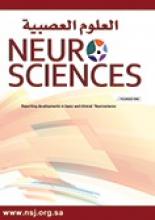A previously healthy 6-year-old girl (Supplement 1) was referred to the Pediatric Department with an acute onset of disturbed level of consciousness and weakness. She developed a fever and dry cough 10 days before admission, for which she had already been prescribed a course of antibiotic. On admission, she was febrile, but her vitals were stable. She had a mildly disturbed level of consciousness, aphasia, and right-sided facial palsy. Motor power was reduced in all 4 limbs, but reduction was more prevalent in the right limbs. Deep tendon reflexes were exaggerated on the right side, with a positive plantar response on the right side. The chest examination revealed crackles on the lower side of the left lung. The chest radiograph showed left lower-zone opacity obscuring the left costophrenic angle (Figure 1A). On the day of her admission, the patient’s level of consciousness rapidly deteriorated, with a Glasgow coma scale level of 8. Consequently, she was intubated and transferred to the Pediatric Intensive Care Unit; she was extubated after 12 days.
- MRI shows A) Chest radiograph showed left lower zone opacity, B and C) MRI of the brain showing multiple hyperintensities, D) MRA absent enhancement of the left posterior circulation
Magnetic resonance imaging of the brain was performed after 2 days and demonstrated hyperintensity in the left cerebellar hemisphere, brainstem (midbrain and pons), left thalamus, and left occipital lobe, with smaller hyperintense areas in the right cerebellar hemisphere ( Figure 1B and 1C ). Magnetic resonance arteriography of the brain, performed on the same day, revealed absent enhancement of the left vertebral artery, basilar artery, and P2 (postcommunicating) segment of the left posterior cerebral artery, suggestive of occlusion. The left posterior communicating artery was absent (Figure 1D). Laboratory investigations showed elevated C-reactive protein levels and a normal erythrocyte sedimentation rate. The antibody titers to Mycoplasma pneumoniae, detected by enzyme-linked immunosorbent assay, were IgM > 150 U/mL and IgG=46 U/mL, indicating acute mycoplasma pneumonia (MP) infection. In addition, polymerase chain reaction testing of the endotracheal tube secretion was positive for M. pneumoniae. The biochemistry profile—including lipid, electrolyte, renal, and bone profile assessments—was within normal limits. The coagulation studies, thrombophilia screen, antiphospholipid screen, and immunology screen were all negative. In addition, the cerebrospinal fluid, electrocardiography, echocardiography, carotid duplex scan, and genetic testing were normal.
The patient was given a 2-week course of clarithromycin, and a low-dose aspirin regimen was started. Furthermore, early physiotherapy was started, which led to moderate improvement of motor function (on the left side more than the right side of the body) and mild improvement of aphasia (Supplement 1).
The ensuing association between MP and stroke remains vague in the literature; the exact pathophysiology and causal mechanism are not yet fully understood. This association has been reported in children, as in our case, in a few case reports.1-3 In 2011, a nationwide study demonstrated that MP is independently associated with risk of subsequent ischemic stroke development in the next 5 years.4
However, more recently, a 2018 systemic review, which used different criteria that included only patients with acute stroke, established that only 28 patients with MP-associated stroke were identified in the literature.5 The review authors concluded that the consensus on this rare but potential cause of stroke is not unanimous and noted that a clear cause of stroke was only identified in 3 patients, one with cerebral vasculitis and 2 with probable paradoxical embolism.5 In addition, results were inconclusive about whether MP was a risk factor that was directly involved in the mechanism of stroke, most probably by affecting the immune hypercoagulable state and inducing vasculitis, or was simply an incidental finding.5
In conclusion, even though the association is limited to reports, the potential risk of cerebral ischemic stroke in children and young adults with M. pneumoniae respiratory tract infections should be noted. Certainly, larger studies are warranted to finally settle this relationship. When it comes to the co-occurrence of MP and stroke it is still unclear if there definite causation, is there an independent association, or is it mere coincidence?
- Received April 11, 2021.
- Accepted July 14, 2021.
- Copyright: © Neurosciences
Neurosciences is an Open Access journal and articles published are distributed under the terms of the Creative Commons Attribution-NonCommercial License (CC BY-NC). Readers may copy, distribute, and display the work for non-commercial purposes with the proper citation of the original work.







